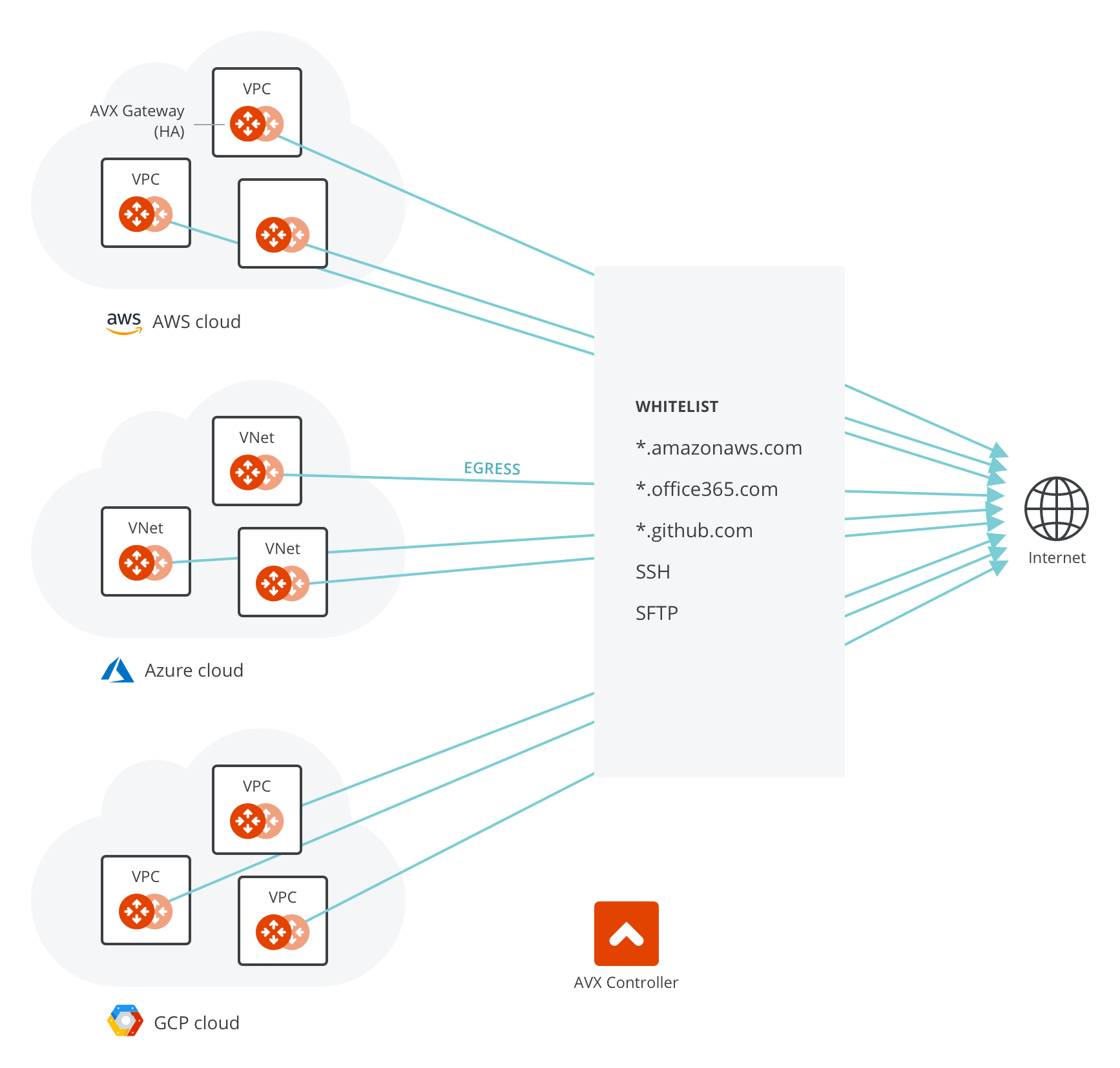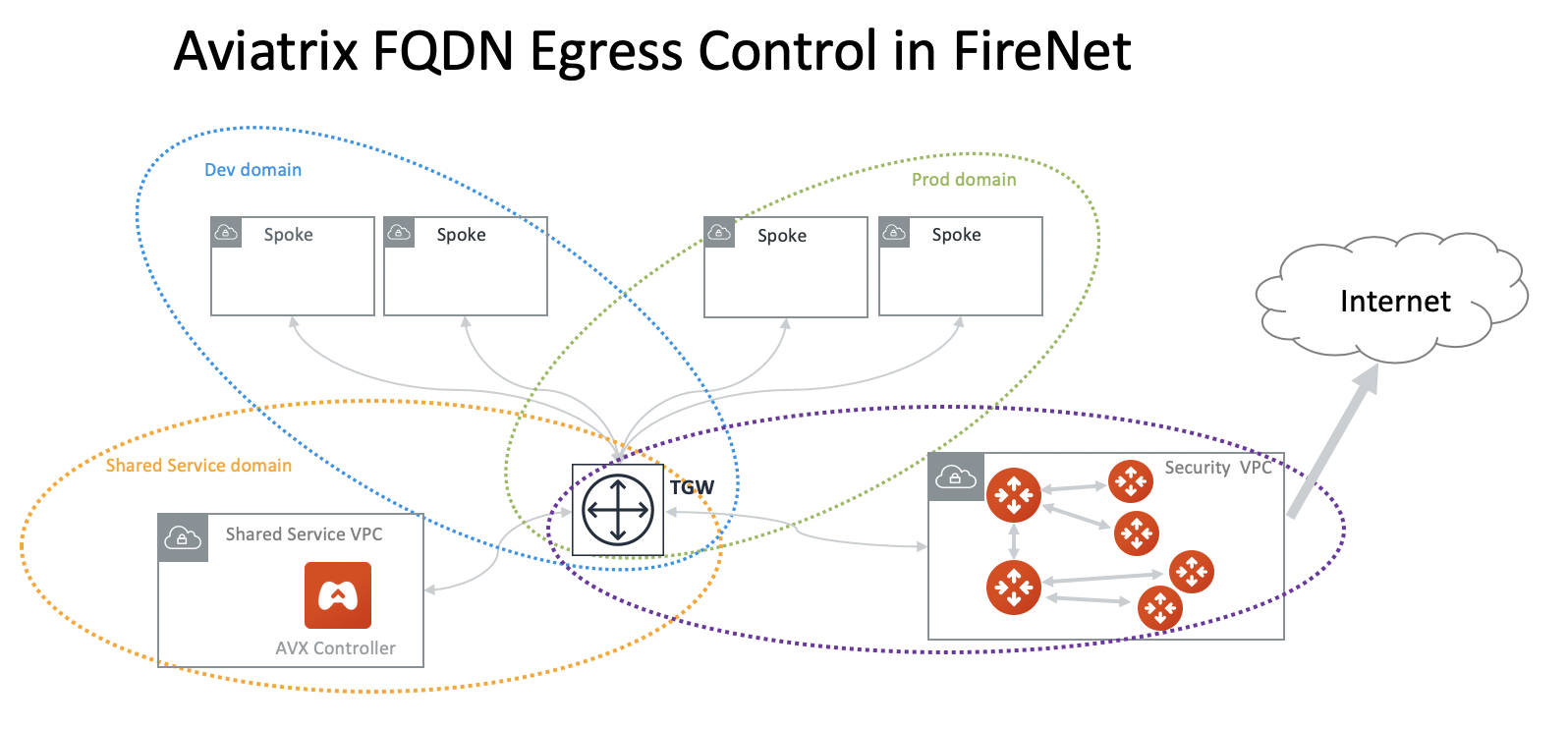Egress FQDN FAQ (Legacy)
|
This document describes Egress functionality available in the Aviatrix Controller prior to Controller version 7.1/CoPilot 3.11. As of Controller 7.1.1710 and CoPilot 3.11, Distributed Cloud Firewall with WebGroups, configured in CoPilot, is the recommended method for configuring and implementing Egress Security. Aviatrix strongly recommends migrating from Egress FQDN Filtering (Legacy) to Distributed Cloud Firewall to enforce Egress network security policy. |
Why is Egress FQDN Filtering needed?

For Internet-bound egress traffic, specifying an outbound policy at the IP address level is not sufficient, as the domain names of a site can be translated to many different IP addresses.
An NAT gateway does not offer security group functions; it relies on security groups from each instance. An NAT instance’s security group does not have enough entries to support the large set of IP address lists. The egress filtering needs to happen at Layer 7.
On the other hand, workloads in AWS are mostly applications or programs where it is deterministic which outbound APIs the application program calls. For example, an application runs API queries to www.salesforce.com for data retrieving and runs API queries to www.google.com for app authentication. In these cases, making sure that only these sites are allowed for egress traffic is sufficient from a security point of view. Note that this is very different from on-prem situations where end user traffic and application traffic are mingled together; you may need a full-fledged firewall for Internet-bound traffic.
Another use case is for PCI DSS compliance. PCI DSS specifies that if you handle any payment and sensitive data, there must be firewall policy enforcement at the egress. In the cloud, the logical egress point is per VPC/VNet.
What does the Aviatrix FQDN Filtering feature do?
Aviatrix Fully Qualified Domain Name (FQDN) is a security service specifically designed for workloads or applications in the public cloud. It filters Internet-bound egress traffic initiated from workloads in a VPC/VNet. This service is centrally managed by the Controller and executed by an Aviatrix Gateway instance in the VPC/VNet in the distributed architecture.
Aviatrix FQDN filters any TCP and UDP traffic including HTTP, HTTPS, and SFTP traffic. The filtering function allows only the destination host names (whitelist) specified in the list to pass and drop all other destinations.
Each destination is specified as a fully qualified domain name. For example, if you only allow Internet bound traffic to www.salesforce.com, you can list the domain name www.salesforce.com in the whitelist.
For HTTP/HTTPS (TCP port 80/443), FQDN feature also supports wild cards, such as *. In this example, you can specify *.salesforce.com to allow traffic to any domain names that end in "salesforce.com."
How does the Aviatrix Egress FQDN Filtering feature work?
The function is transparent to individual instances and is carried out inline without requiring any certificate or keys to decrypt the traffic.
Non-HTTP/HTTPS traffic can also be filtered based on exact domain names. Use cases are secure file transfer (SFTP) to external sites, secure login in (SSH) to external sites.
A tag is defined as a list of FQDNs and it is created and managed on the Controller console. One or more gateways may be attached to a tag; each gateway can be attached to more than one tag. Any updates to a tag on the Controller automatically triggers updates to all gateways attached to the tag.
Multiple tags can be defined for the Controller. The domains in the tag are the destinations that are allowed for traffic to pass.
For configuration details, refer to this document.
How do I troubleshoot FQDN problems?
If you have problems with FQDN on a specific gateway, follow the instructions below to troubleshoot:
-
Make sure the corresponding AWS or Azure route table has the route entry 0.0.0.0/0 which points to the gateway instance.
-
To verify that the above step is set up properly, disable the FQDN function of the problem gateway by detaching it from the associated tag, and run a ping test to www.yahoo.com from an instance in the private subnet to make sure Internet egress works.
-
Attach the problem gateway to the tag. Make sure the tag is Enabled.
-
Make sure the Whitelist or Blacklist is selected as intended.
-
Check the tag to make sure it has the intended URL configured.
-
Run a wget test from a private instance in the VPC/VNet to a URL configured in the tag.
-
Go to Security > Egress Control > Egress FQDN Gateway View.
-
Select the problem gateway and download the log. Review the log file and analyze if the intended URL is in the log entry, why it is being accepted or denied.
| If a tag has the White list option selected, all URLs in the tag will be accepted. On the other hand, if a tag has a Black list option selected, all URLs in the tag will be dropped. |
-
If none of the above work, try to Disable and Enable the tag again. This will restart the FQDN function on all attached gateways.
Any vendor specific comments to be noted for Egress FQDN Filtering?
Any GCP instance (excluding Controller-created gateways) that needs to participate in egress control (FQDN, SNAT and FW Egress) has to be tagged as "avx-snat-noip". The GCE network tag "avx-snat-noip" can be associated during GCP instance creation or by editing an existing instance.
What happens if I enable FQDN and there are route tables that have an existing default route?
When enabling egress filtering on a VPC/VNet, each subnet’s route table is reviewed. If there is an existing default route (0.0.0.0/0) in the route table, the following logic is used:
| Target | Aviatrix action |
|---|---|
igw-* |
Ignore this route table |
anything other than igw-* |
Update the Target to point to the AVX GW ENI and remember the current value of Target. (see note below) |
|
If the Gateway is detached from the VPC/VNet (via the egress configuration page), the route table will be updated with the original values. |
Can FQDN gateway be deployed in a central place?
Yes. Available in Release 5.0 and later, Aviatrix FQDN gateway can be deployed centrally in the TGW environment as shown in the diagram below.

One use case is if you need to limit the public IP addresses to a third-party public service.
How do FQDN and Stateful Firewall work together?
If FQDN service is enabled on a gateway for any TCP port 80 and 443 traffic, all forwarding traffic to destination TCP port 80 and 443 are processed by FQDN engine and the decision to drop or accept the session is reached by FQDN engine. Stateful firewall can only process traffic destined to non TCP port 80 and 443.
How does FQDN process rules in order?
Since you can create multiple tags with each consisting of a list of FQDN rules, the Controller must merge these rules in a specific order before sending these rules to FQDN gateway for processing.
The Controller merges all FQDN rules by this order:
-
If the rule ACTION is Deny, it is placed in the first block for processing, that is, they are processed first.
-
Within each block (Deny, Allow, Base Policy), the more specific rules are processed or examined first. For example, salesforce.com is more specific than *.salesforce.com therefore salesforce.com is processed first.
-
Each rule has a verdict, Accept or Drop. When the FQDN processing engine finds a match, the verdict is reached and the packet is either dropped or accepted. The processing engine does not continue on to the next rule.
FQDN Option for Exact Match
If a FQDN rule does not have * an exact match is expected. If this global option is not enabled, FQDN rules use regex to match any FQDN names that are a subset of the name. For example, if salesforce.com is a rule and the Exact Match option is enabled, finance.salesforce.com is not a match and will be dropped.